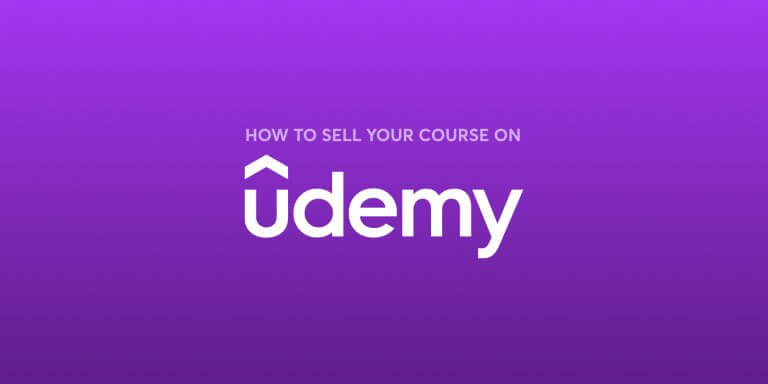Table of Contents
Udemy has over 70 million learners, making it a first choice for anyone looking to launch their initial courses.
This said, one of the biggest benefits of using Udemy is that it allows you to test different course formats and topics before you venture into investing more in your courses.
That’s also why I started using Udemy at some point. Despite being a marketer myself, I didn’t have the time to market my own courses. On top of this, I wasn’t sure some of the more unique topics I was tackling would attract students.
Udemy seemed like the perfect option to get rid of these challenges. And it did. Except I got to a point where I simply needed to scale to see the profit. And Udemy was taking a huge chunk of my earnings while putting the popular course creators in the forefront.
Small, up-and-coming instructors had no chance of scoring a top spot within their course page results for popular topics. I did, however, manage to get one of my topics for beginners to be popular. For a short while, though. So, I was stuck creating lots of smaller courses for lesser-known topics. A huge waste of time since the earnings were minimal.
What I wish I knew at the time is that I should have invested straightaway in an Udemy alternative like LearnWorlds that would let me create and sell online courses from my website and keep 100% of the profits from course sales.
So, in this guide, I’m showing you how to sell your courses on Udemy, given the competitive market. Plus, I’ll be covering some of the better options you have to make sure you’re not losing out on the profits.
Step-by-Step Guide to Sell Your Course on Udemy
To make this list easy to use, I’ve broken down the process of selling your course on Udemy into actionable steps:
1. Setting up an Udemy Instructor account
To become an Udemy instructor you first need to create a regular student account. You’ll then have to go through a series of quick steps that are meant to give Udemy more insights into your teaching background.
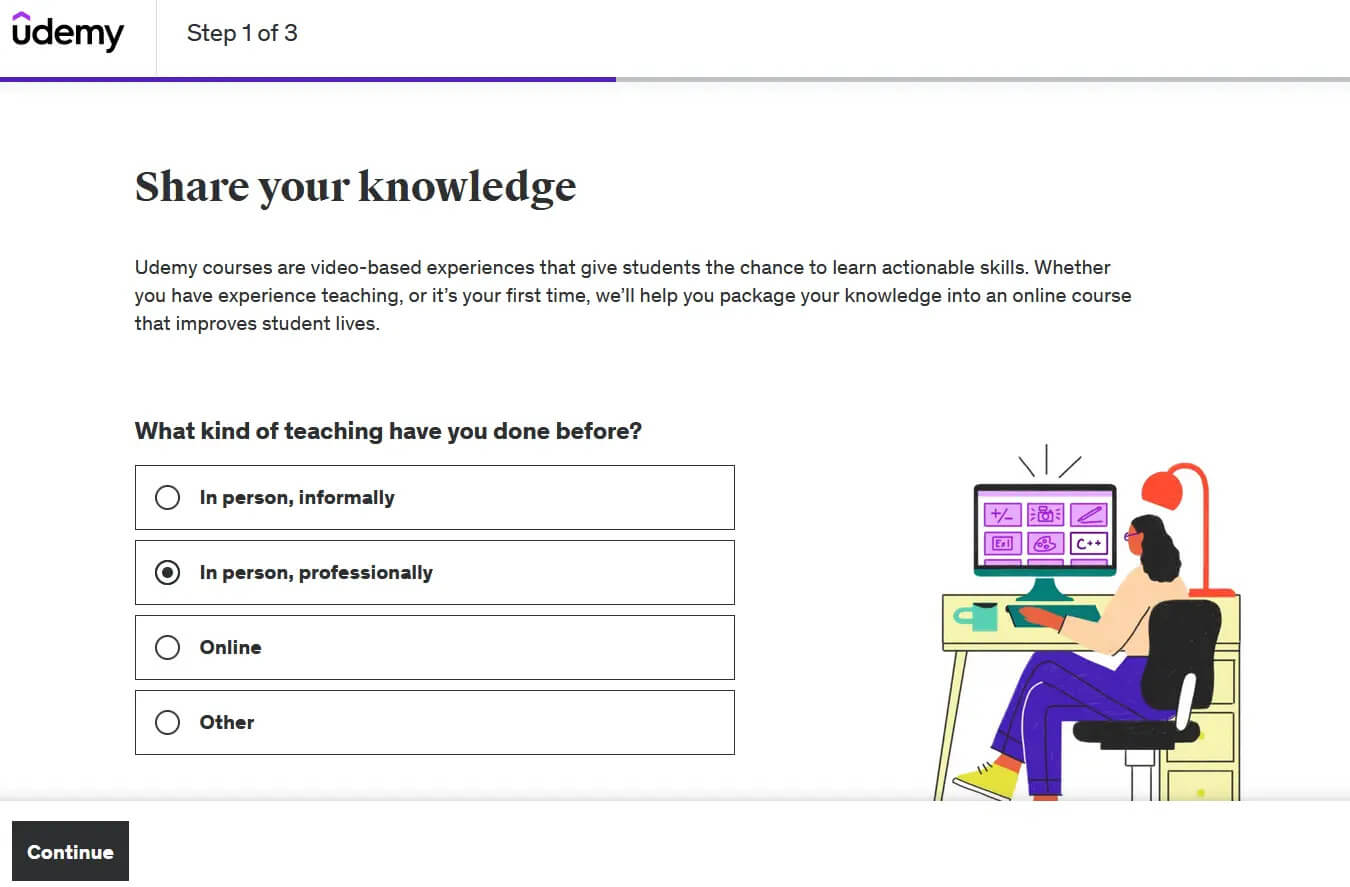
And that’s it. You’re in! Udemy is built for experienced and beginner instructors alike, so there’s no gated process or pre-approvals needed so you can create your first course.
Remember your new profile will come with a public bio page:

You can add the basics now and edit it later once you’ve picked out a niche and have a rough idea of what makes you stand out as an Udemy instructor.
2. Choosing a niche
Choosing a niche is important for two core reasons:
For me, picking a niche was easy. I took what I was best at and stuck with it. In my case, that was organic digital marketing, but there are hundreds of niches to pick from:
Tip: You can even create a new niche yourself or leverage upcoming trends to be the first to tackle the topics with a Udemy course. This will give you a headstart in that space and also prompt students to follow your courses if they want to stay on top of trends.
3. Preparing your equipment
You should invest in basic equipment even at the beginning. A decent camera, mic, and video editing program will do.
It all depends on your course’s format, though. My first courses were screen-shared. I took a presentation and just talked on top of it. While years ago, when I started, this was enough, simply having good information to share isn’t enough. You need the professional camera and audio setup to convince students to choose you over other instructors — in other words, to look like a pro.
Besides this, there are also Udemy’s own quality requirements you need to follow.
I learned this the hard way and ended up with an entire set of videos that weren’t recorded at the right size. And yes, I had to film it all again.
Here’s what Udemy’s minimum course requirements checklist looks like:
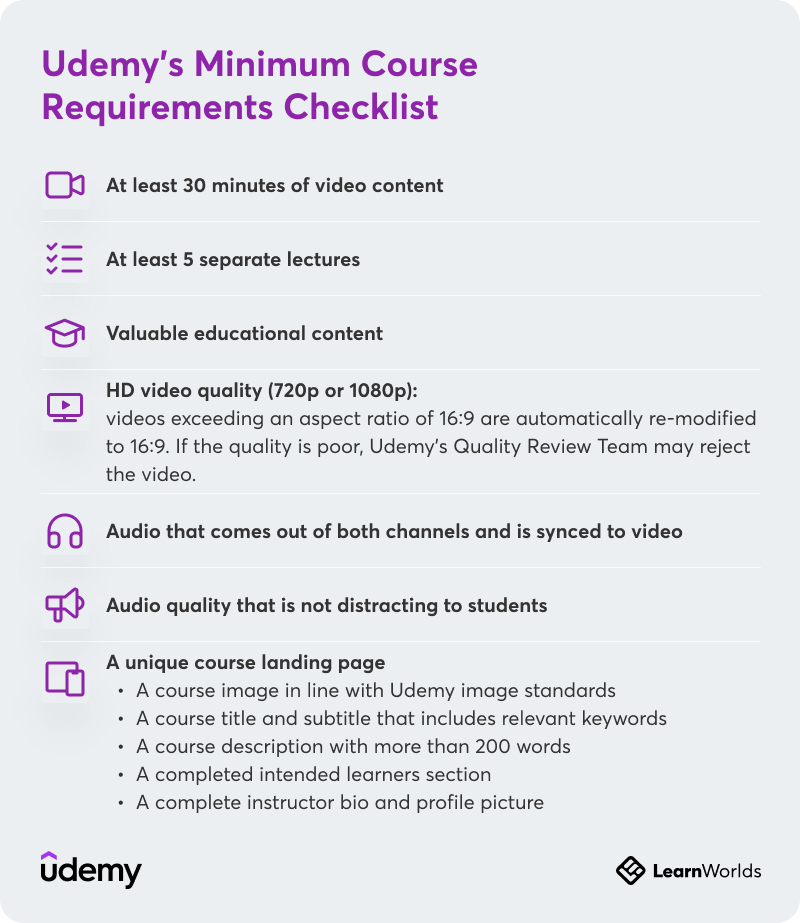
4. Relying on the Udemy Marketplace Insights to choose topics
On Udemy, you can’t just create a course for the topics you’re best at. You need to go beyond this and analyze what Udemy’s student base actually wants to learn.
Unfortunately, I didn’t use Udemy Marketplace Insights because the tool wasn’t ready at the time. Still, this is a very useful tool for understanding if investing your time into a course is worth it.
Let’s take a widely covered course topic like Digital Marketing as an example:
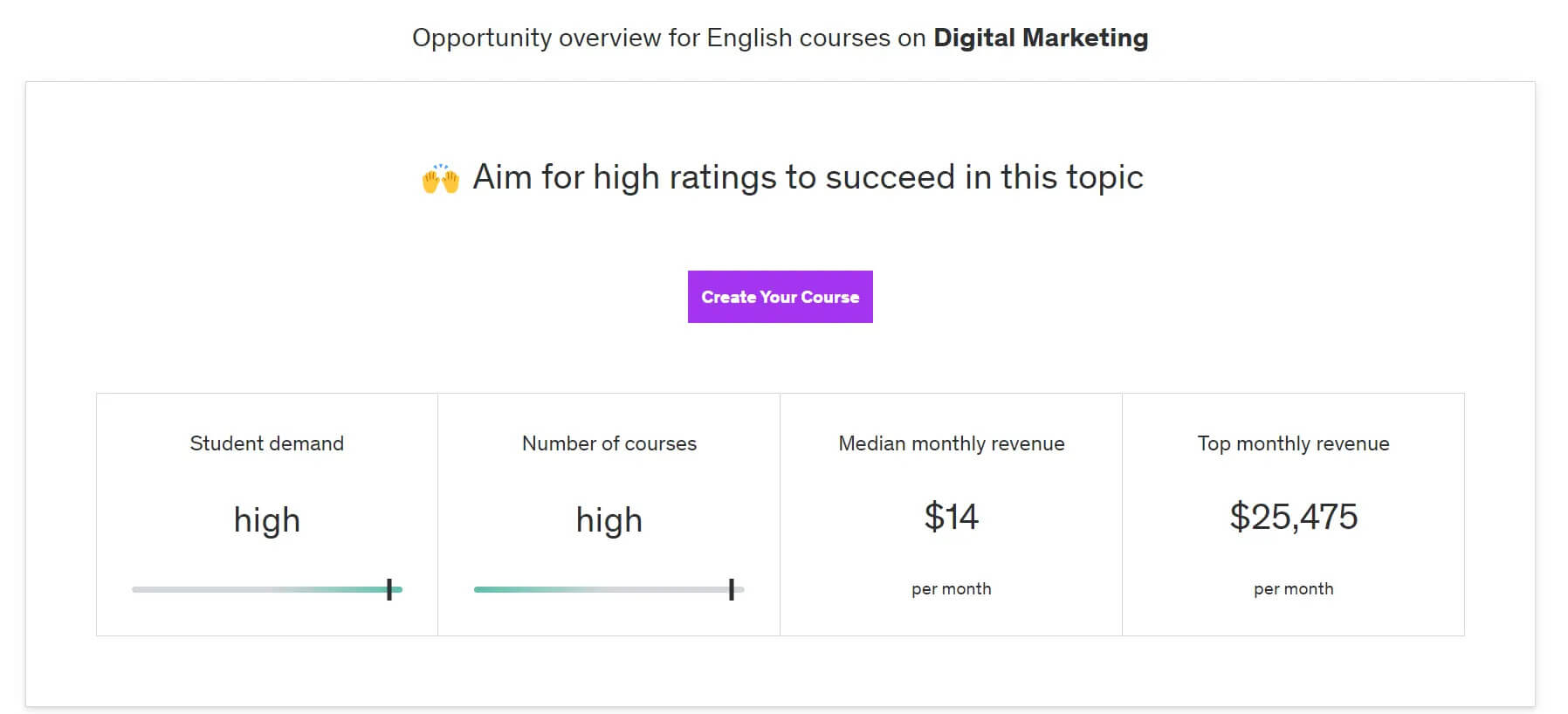
You’ll immediately get Udemy’s best recommendations for this topic, and trust me, they’re accurate.
For Digital Marketing, despite the high demand, there are already too many courses out there. So, while Udemy recommends getting high ratings to succeed in the topic (and this is super true!), it’s practically impossible to do this as a beginner.
You’d either need pre-existing credibility on Udemy or an external audience you can bring into Udemy. Note you wouldn’t really do the latter since having an audience means you could sell your own courses on your platform without having to share profits with Udemy.
That’s why only 8.2% of enrollments for courses on Digital Marketing come from outside sources:

You could use the same tool to get some better ideas for topics of interest, though:
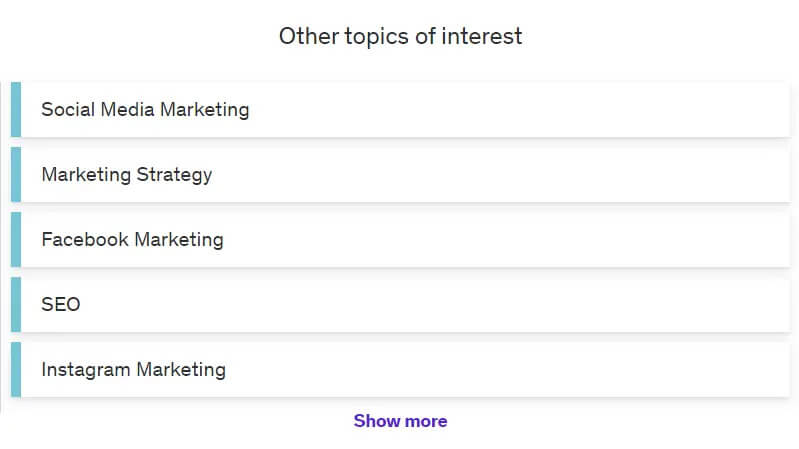
The problem is that Udemy has over 75000 instructors. So most of the big topics with a higher demand have already been covered. There’s no solution to this problem besides the extreme ones:
Tip: Just before you hit search, Udemy’s Marketplace Insights will give you a list of promising topics you can focus on:
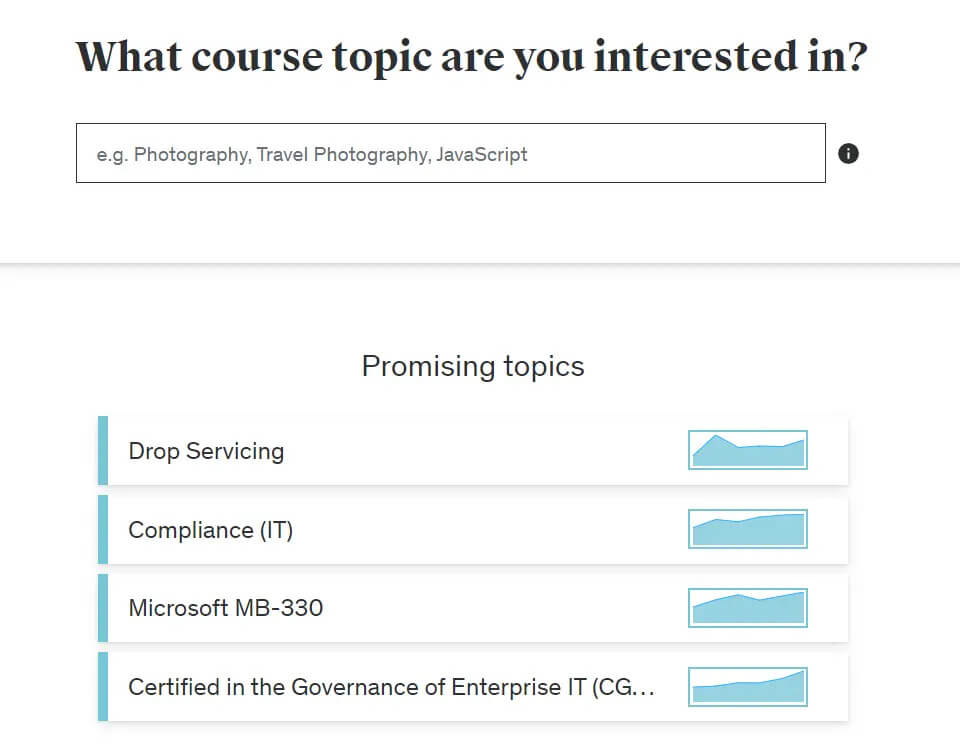
5. Take a look at your competition and find what makes you unique
The same Udemy Marketplace Insights will showcase the top-earning courses for a given topic:
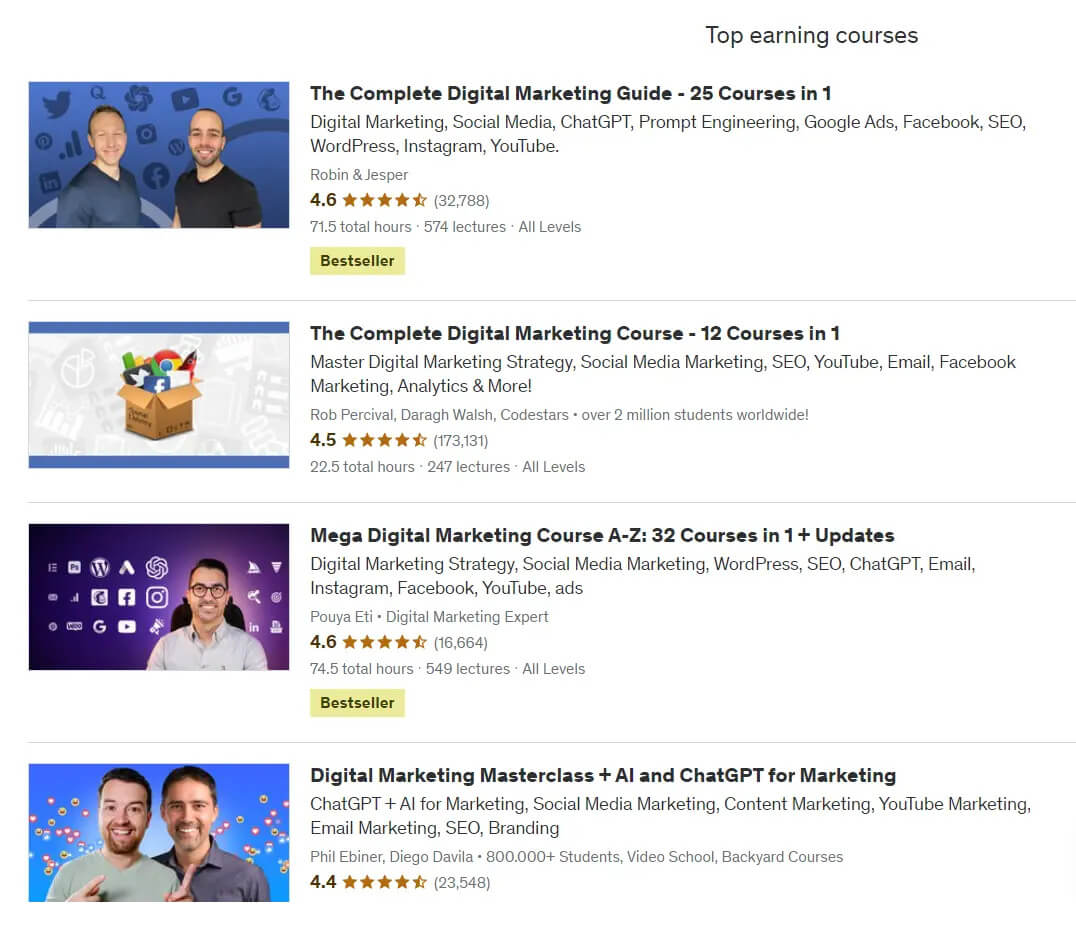
I analyzed competitors a lot whenever I felt like I wasn’t getting the traction I wanted. Your courses can always be tweaked after you’ve published them to make sure they stand out. Your competitors are already doing this, and it would be great for your online business.
Plus, looking at other course offerings means you can identify what makes you stand out. I recommend doing this even before you create your new course strategy. This will allow you to incorporate some of these unique elements into the courses’ curriculum and subsequent promotion strategies (such as offering a free course).
I kept it simple and focused on delivering a step-by-step, detailed approach to everything. This meant my students could immediately apply the courses’ learnings. Plus, I was getting this feedback from their reviews. A lot of reviews will TELL you why you’re unique, so you don’t even have to worry about determining the value of your online course.
Still, here are some other ways in which you can stand out on the Udemy platform:
6. Creating your course
Drop an eye over our guide to a successful online course creation first.
When it comes to an Udemy course in particular, remember to stick to their minimum requirements checklist and try to deliver more than competing courses do.
Start by creating your course outline, and gradually build your course content, adding your learning activities to each section based on topic relevance.
7. Choosing how you’ll market your course
You have endless marketing opportunities to sell your course on Udemy. This means you can use any traditional and digital marketing opportunity like social media, email marketing, content marketing, ads, coupon sharing, PR, and more.
Udemy does offer its own tools for promoting your courses within its platform.
The most important part? Building a community.
On the left side of your Udemy instructor dashboard, you’ll find an entire Communication section:
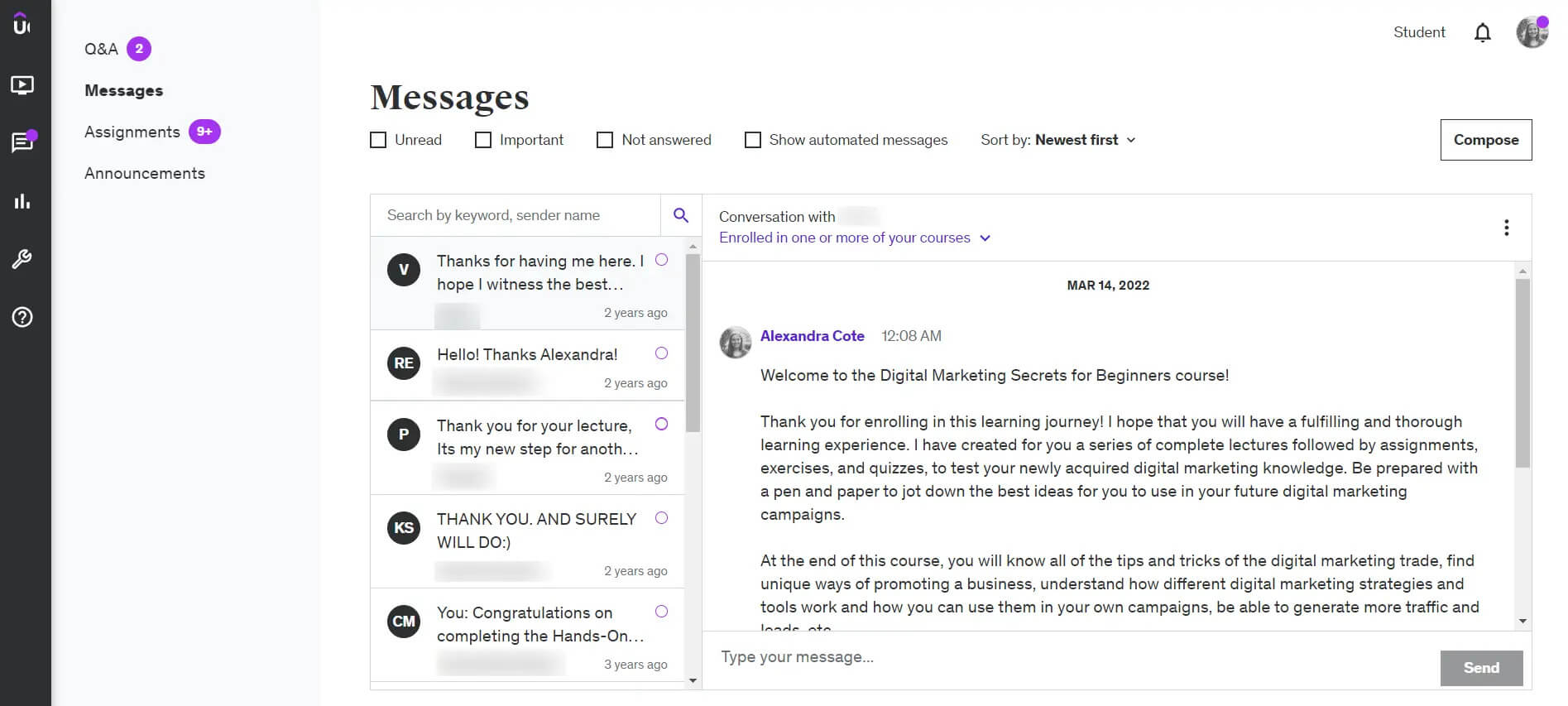
This is where you can keep in touch with your students, answer their questions, review assignments, and, above all, send instructor announcements.
Always read their communication rules and guidelines before sending anything, though.
External links you add should always lead to educational content. You can’t use Udemy’s announcements to promote other products you sell or lead students to gated content.
You do have some level of freedom to experiment with these announcements though. For instance, you can link to Google Hangouts on Air, Spreecast, or GoToMeeting and host your own webinars. These are a fun idea if you want to build a one-on-one relationship with students and give them an extra opportunity to learn. Plus, live events can be a unique selling point too if you have the time to host them regularly.
💁🏻 Here are 30 popular ideas on how to promote your online courses.
8. Updating your courses regularly
This is where I stopped.
Hosting my courses on Udemy was becoming more of an active job as opposed to earning me the passive income I was hoping for.
However, having up-to-date content is what’s going to keep you at the top of the course results for years. How often you update an Udemy course depends on how fast-paced your industry is. This paid course in marketing, for example, gets updated every single month:
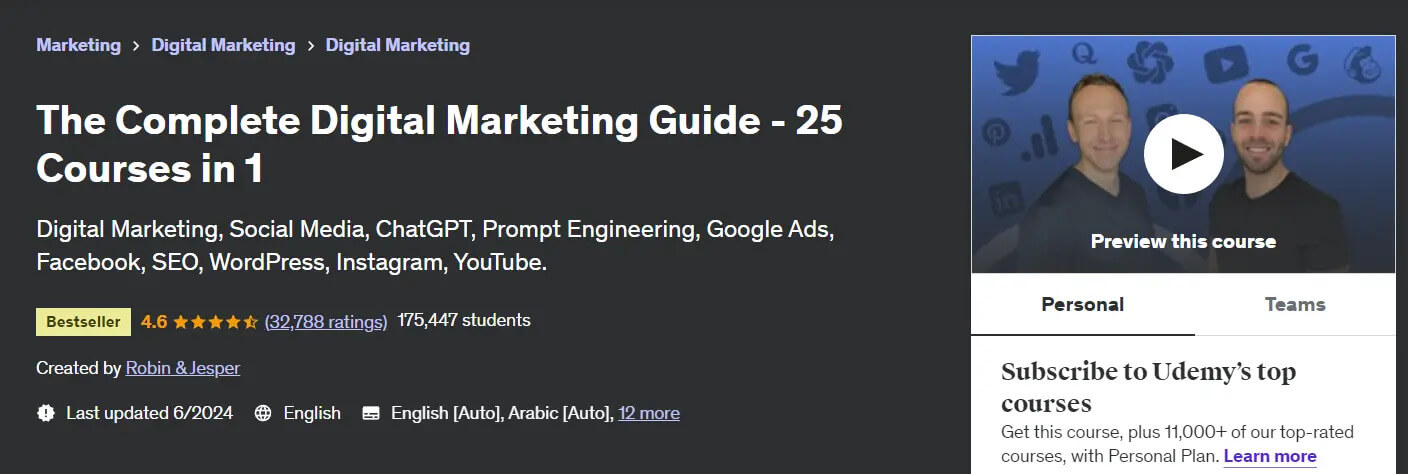
Core points you should update regularly in your Udemy course include:
The Best Alternative to Sell Your Courses
While Udemy is a great place to test your first courses and even create an initial audience, it’s not the best option once you scale.
If Udemy isn’t the right fit for you, then an online course platform or a course-only marketplace might be the right option.
LearnWorlds, the Best Cloud-Based Course Platform
LearnWorlds stands out as the best eLearning solution; you can create, market, and sell online courses. With its suite of cutting-edge features, LearnWorlds provides everything you need to effectively monetize your expertise and engage with your students.
At its core, LearnWorlds boasts a powerful AI assistant that streamlines course creation. It also features a robust no-code Website Builder and a Mobile App Builder, enabling you to craft fully branded mobile learning experiences.
While Udemy keeps a significant percentage of sales, LearnWorlds takes a different approach:
Take a look at LearnWorlds with a 30-day free trial and start building your first course.
Frequently Asked Questions (FAQs)
Is it worth selling courses on Udemy?
Think of Udemy as better suited for testing out your instructor’s capabilities and market demands. There are no upfront costs, but Udemy takes a significant cut of your course sales, which can be as high as 50% or more, depending on how students find your course (e.g., through Udemy’s own promotions or your marketing efforts).
How much can you make selling on Udemy?
The Udemy Marketplace Insights will give you an estimate of how much you can expect to earn. A Web Design course, for instance, has a median monthly revenue of $20/month and a top monthly revenue of $3,672/month. This said, with the massive chunk of money Udemy takes from your earnings, you’ll need to become one of the top instructors to earn significant sums.
What courses make the most money on Udemy?
As long as you have one of the most popular courses for your topic of choice, you’re all set. However, some courses in high-demand categories, such as Web Development, Marketing, or Finance, will help you earn more. For Web Development, the top monthly revenue is $42,106/month, but there’s a lot of competition. With so many instructors, the median monthly revenue is a mere $18/month.

Alexandra Cote
Alexandra Cote is a SaaS growth marketer and online instructor who's worked with dozens of brands in the MarTech, HR tech, and productivity space. She's also a strong supporter of staying happy at work and choosing a healthy career path.

